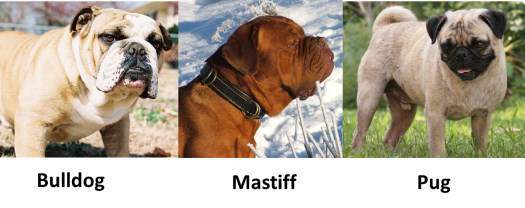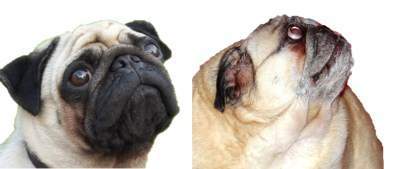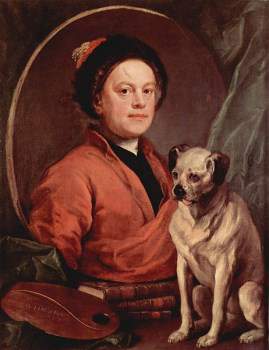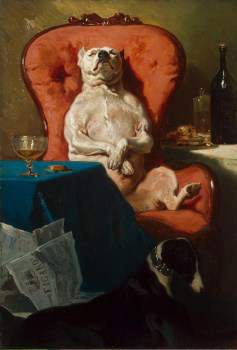Chinese Pug Dog

Chinese Pug Dogs
Overview
What is a Chinese Pug dog? Since there is only one Pug breed, with no other official variations or off-shoots, a Chinese Pug is not its own breed and it is not a type or variety of the Pug. This term is generally used in 1 of 3 different ways:
1)
It is sometimes used as an alternate name for a Pug. The reason for this is that the breed's origin lies in China.
2)
It is sometimes implemented as a marketing ploy to try and make potential puppy buyers think that they are obtaining a special Pug that is different than the standard.
3)
In some cases, due to poor breeding practices or intentionally by unethical breeders, Pugs will be bred to have super flat faces and stockier bodies.
They are then dubbed 'Chinese' and unfortunately due to a shortened face on an already Brachycephalic breed, these dogs have major health issues including elongated palate, stenotic nares and severe breathing problems.
In this section, we will go over each of these reasons why a dog may be dubbed a Chinese Pug.
Using the Term Chinese Pug as an Alternate Name
There are several official and unofficial names for the Pug dog. This includes:
Chinese Pug -
This breed has a rich and interesting history of origin in China. For this reason, calling a Pug a Chinese Pug brings reference to both his ancient bloodline and his official breed name. In most cases, this term is just a nickname; it has become popular vernacular since this breed originated in 16th China before it was brought to other countries across Europe - most notably the Netherlands and the United Kingdom- for further development.

Dutch Bulldog -
This moniker began in the Netherlands since the Pug somewhat resembles a Bulldog
Dutch Mastiff, Mini Mastiff -
These are the terms that we were often used to described a Pug when the breed was first brought to Holland since his wrinkled appearance reminded the Dutch of Mastiff, though to a much lesser extent.
Mops -
The German word for Pugs is Mopshund, which is shortened to Mops.
Carlin -
In France, people call the Pug a Carlin because the breed was named after a famous actor namedCarlo Bertinazzi who played the role of Harlequin, who wore a black mask.
Using the Term Chinese Pug as a Marketing Ploy
The AKC, KC, CKC, FCI and all other major, reputable dog breed organization only recognize one breed: the Pug, which is in the Toy category. Weighing between 13-18 pounds (5.89 -8.16 kg), this dog is the largest of all of the toy breeds. There is no such thing as a long haired Pug, miniature Pug, Chinese Pug or any other offshoot that would lead one to believe that there is a variation of the breed.
In some parts of the world, due to high competition in the breeding world, some breeders try to gain an unethical advantage by marketing puppies as either 1) having a royal bloodline or 2) being a 'special' type of Pug. In both cases, the dogs will be labeled as Chinese Pugs. If bred correctly, these dogs will have the exact same body structure and appearance of a 'normal' Pug dog.
Any breeder that is advertising puppies as being Chinese Pugs - implying a royal bloodline or a 'new, perfected' variety - is misleading the public. This breed is so ancient - with early breeding documents being purposefully destroyed to hide the breed's secrets -
and has been developed over the centuries in so many different countries that it is not possible to locate an 'ancient' genetic bloodline that would directly tie any current dog to his mysterious ancestors.
Pugs with an Altered Appearance that are Dubbed Chinese Pugs

Standard Pug VS Pug with Severely Altered Flat Muzzle
Due to very poor breeding practices or due to purposeful unethical breeding, two Pugs that have overly flat faces - and often with a much stockier body - will be paired together.
Ethical breeding dictates that the goal is for the betterment of the breed; normally one flaw can be balanced by another dog's strength. However, when a Pug has an altered appearance that deviates substantially from the breed standard, the opposite has happened with two flawed dog producing flawed puppies.
In these cases - whether accidental or on purpose - the resulting litter may be dubbed Chinese Pug dogs in order to sell the dogs for more money based on a unique physical stature. It should be noted that these types of altered Pugs will have severe breathing problems, among other health issues
that some into play with overly compressed facial structure. Often these dogs are said to be closer in appearance to their predecessors, although quite the opposite is true
The Pug's ancestors did not have flat faces - While this breed originated in China, there are no documents proving his appearance at that point in history. However, if we look at the breed 300 years ago and what he looks like today, we can see a development over the past 3 centuries in which the face gradually became shortened.
This leads us to believe that ancestors certainly did not have a lack of snout if this was only a relatively recent change.
For this reason, a so-called Chinese Pug would not have a flat face. Pugs from several hundred years ago actually had notably longer snouts than the Pug that we know of today along with longer legs and a leaner physique. Paintings of Pugs began appearing in the late 1700's and early 1800's, most famously by the painter Francisco José de Goya y Lucientes.
To look into this further, we can note the remarkable painting from 1745 of English painter/sculptor William Hogarth (1697 – 1764) which shows his Pug named Trump to have a moderate snout and wide-chested yet lean body.
Paintings all throughout the 18th and 19th centuries show Pugs to have moderate snouts, tails
with just one curl, a wide chest, moderately long legs, small ears
and no apparent large, bulging eyes or flattened face and forehead. These traits, therefore, must have been perfected in Europe over the late 1800's and early 1900's.

Image: William Hogarth [Public domain], via Wikimedia Commons
The Original Chinese Pugs of the Shang Dynasty
The Shang Dynasty, which ruled China from 1766 BC and 1122 BC, bred Pugs for pets. And not just any common pet; They were called Lo-Chiang-Sze, although the term Foo was also used. They were kept by royalty, often dressed up in clothing and given the best of care.
As time went by, Buddhist monks in Tibet were said to have Pugs as pets, living in their temples and treated with the utmost respect.
For unknown reasons, but perhaps to keep the “secret” of this breed from outsiders, the first Emperor of China, Qin Shi Huang, had all records of the Pug breed destroyed. This including breeding records, names of both dog and owner and all art (drawings, paintings, etc.)
Chinese Pug lions refer to the statues that were placed outside temples and other important buildings. They were called Chinese fu dogs, fo dogs and lion dogs. These sculptures were thought to hold great powers of protection, each serving as a sort of guardian to both structure and inhabitants.
A Move into the Modern World
During the 1500 and 1600's the Pug was brought into countries across Europe. While the term Chinese Pug was undoubtedly used at first to describe where the dog originated from, it would not be long before his popularity blossomed and countries such as Holland and the UK would create breeding programs to alter the appearance of the dog in some notable ways.
Possibly with the aid of a new group of Pugs imported directly from China, bred with the Pugs currently in kennels, snouts were shortened and eyes became more pronounced, with an emphasis to keep the wonderful wrinkles of the forehead intact.
By 1900, all well known kennel clubs around the world, including the AKC, officially recognized the Pug. Though they are also officially also called Carlins (France) and Mops (many European countries), all clubs do recognized its nickname of Chinese Pug.

Oil painting "Pug Dog in an Armchair" by artist Alfred de Dreux, 1857
Alfred de Dreux [Public domain], via Wikimedia Commons
PetPugDog.com Copyright 2019. All rights reserved. Privacy Policy
We are a participant in the Amazon Services LLC Associates Program, an affiliate advertising program designed to provide a means for us to earn fees by linking to Amazon.com and affiliated sites.


